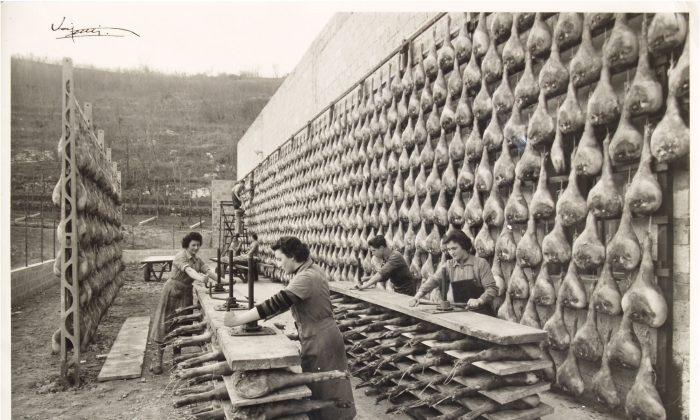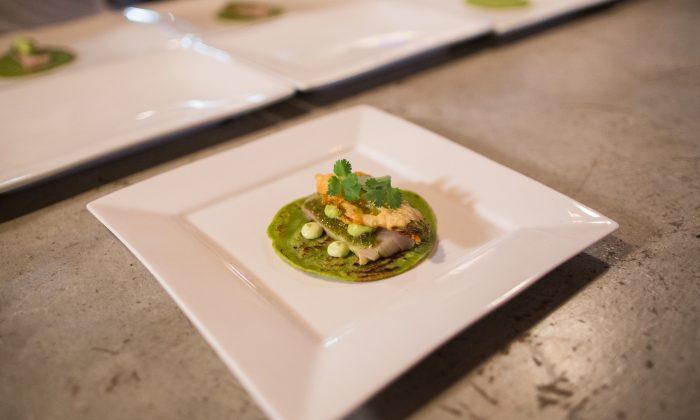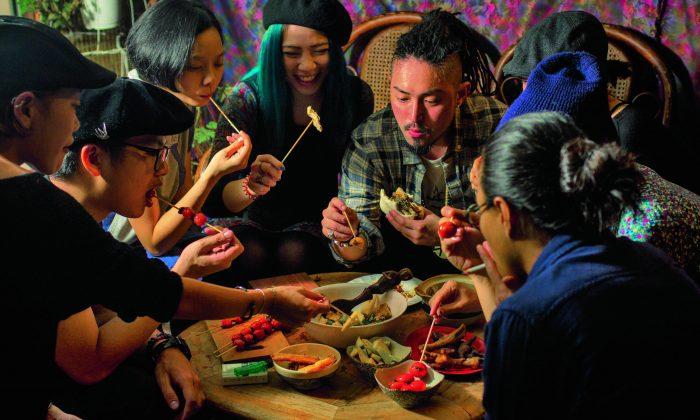Every beloved restaurant has its own formula for pleasing customers. At Osteria del Principe, the equation is one part good old-fashioned Italian warmth, one part Italian wines, and one part prosciutto. And not just any prosciutto; this osteria is the flagship store for Principe, Italy’s leading producer of prosciutto.
The cured ham comes from the likes of San Daniele and Parma, where the sweet alchemy of pork, salt, air, and time work their magic to create something rapturous and ambrosial.
The microclimatic conditions in San Daniele, central Friuli, are perfect for curing meat. Positioned on a hill, San Daniele is the recipient of cool mountain air from the Alps to the north, and the warm, salty breeze from the Adriatic to the south, which cools as it travels alongside the Tagliamento River.
Thousands of years ago, the Romans and Celts knew well enough to cure and preserve meats there.
From the 13th century on there was evidence that prosciutto was used for barter. According to the Consorzio del Prosciutto di San Daniele, legs of ham were sent by the Municipality of San Daniele to the Doge of Venice in exchange for arms and labor during Turkish incursions.
San Daniele enjoyed centuries of prosperity. The small municipality passed from Venice to Austria in 1797, and when it was sacked by Napoleon’s army, the French officers made sure to plunder the hams, along with precious illuminated manuscripts.
Over time, the worldwide demand has required scaling up via some technology, but the legs of ham, matured from 13–20 months, are still very artisanal. The meat gets a fair amount of hands-on attention, from salting to massaging for more tender ham, to the application of sugna, a pork mixture to prevent excessive drying.
The prosciutto at Osteria del Principe, which is certified with the PDO status (Protected Designation of Origin), is non-GMO, free of any chemical additives, and is gluten-free. The pigs are born and raised in any of 10 specified Italian provinces.
The Principe business, which was started 60 years ago in 1945 when Stefano Dukcevich founded a small lab for ham and sausage production, has remained in the family, now headed by third-generation Vladimir Dukcevich.
The Osteria
Osteria del Principe, just a few steps from Madison Square Park, is run by a charming young couple from Trieste, Italy, Carlotta Paolini and Massimiliano Cortese.
In Italy, where food is practically a way of life, there are different categories for restaurants, and an osteria tends toward the informal—where you can drop by for a little bite or drink any time of day. In the afternoon, stop in for a “merenda” or an afternoon snack; after work, take your aperitivo there. That’s not to mention lunch or dinner, of course.
Both Paolini and Cortese are keenly aware that in this day and age, everyone is so busy that they’re not spending much time at home anymore. The osteria, in a way, is a home away from home.
Osteria del Principe has been open since last summer, and though the official sign just went up last week, it has already amassed regulars, who adore the hospitality. No one is ever rushed out (Paolini stayed till 2 a.m. to accommodate guests during Fashion Week, on an evening when the restaurant normally closes at 10:30 p.m.). And “If [guests] come by themselves, we take them by the hand,” she said.
“The most beautiful compliment [customers] gave us was, ‘Oh Mamma mia, it’s like eating in my grandma’s house.’ For us, it’s the maximum,” she said.
And where in more formal places, you might have a constellation of staff from manager to waiter to runner to busboy; here it’s different. You’ll find Paolini and Cortese just as likely to take orders or bussing tables if need be. “We want to be with the customers,” Paolini said. “And you know, with the Italians, when you take a little bit of confidence with the owner, you sit with them, you offer them a glass of wine, you talk.”
A Curated Menu
Like a regular osteria, the menu at Osteria del Principe is concise.
One of the best ways to start off is to kick back with a glass of wine and nibble on a sampling of the cured meats and cheeses, or “giardinetto” (meaning, little garden). Paolini said, “Every house, every osteria has different giardinetto,” essentially whatever you can find.
Order the tagliere Principe (tagliere means “cutting board”), and you’ll get a chef’s selection of three cured meats and two cheeses, along with olives and almonds ($20), perfect for sharing.
You’ll get slices of San Daniele prosciutto, aged for 16 months, whose aroma is incredibly enticing. The slices are melt-in-your-mouth tender, and surprisingly multidimensional in taste—not flat and salty, but buttery, savory, and sweet all at once. The longer the aging process, the softer and sweeter a prosciutto becomes.
The San Daniele prosciutto produced by Principe holds the distinction of not being too salty, as prosciutto sometimes tends to be.
Principe also produces a Parma prosciutto, whose slices you can taste alongside the San Daniele—reflecting those climatic differences where it is matured, in Emilia-Romagna.
As for the cheeses, on my tagliere there was Bella Lodi, an aged cow milk from Lombardy, and Asiago d’Allevo, a raw cow milk cheese from Triveneto. But if you are a fan of blue, there is also Gorgonzola, or if you prefer a nuttier cheese, Taleggio. There is one that is a must-have, but is best had in an incredible duo —the burrata with San Daniele prosciutto ($20).
It’s an exalted marriage of texture and flavor. To be honest, it makes my brain fuzzy just to think about it. On the one hand you’ve got the burrata, which looks, like a ball of mozzarella—fairly innocent stuff. But prod it, and it’s soft and pliable. The mozzarella is but just a thin wall that, when cut, gives way to a glorious, oozing cream. Pair it with 18-month-old San Daniele prosciutto, and the result is harmony.
There is also the exquisite prosciutto cotto—slowly cooked ham—whose flavor is wonderfully delicate, nuanced with rosemary or truffle.
There are also bresaola, speck, and mortadella, again all produced by Principe.
A lovely, simple dish is the risotto al Franciacorta, with prosciutto, Bella Lodi cheese, and Franciacorta—a sparkling wine from Lombardy whose flavor comes through loud and clear.
Pasta is made fresh every day on the premises, and there is always a daily freshly made pasta special available ($16/$20).
It’s genuine Italian here, not the Italian-American fare that’s evolved on the side of the Atlantic. Hence, no fettuccine Alfredo, or penne alla vodka, or chicken Parmigiano.
What you’ll find, besides dishes that showcase prosciutto (like the popular spaghetti carbonara, with prosciutto instead of bacon), and classic Italian fare like risotto or lasagna alla Bolognese, are specials that come from Trieste.
For thousands of years, Trieste has been at the crossroads of three civilizations: Latin, Austro-Hungarian, and Slavic. It was under Austrian rule as late as the early 20th century.
And so the culinary tradition offers specialties like yota, a soup made of sauerkraut and beans, or calandraca, with veal and potatoes, or even goulash. For these specials, it is Paolini’s mother, an accomplished cook back in Trieste, who is consulted. “She has a lot of secrets in her pockets that she waits to take out of her pocket—like a magician,” said Paolini.
For dessert there is a strudel di mele (In Italian called “Strucolo de Pomi” ($9), unlike anything you might see in a store, a thin flaky pastry encasing apples, raisins, and pine nuts, and cinnamon. Served warm, it goes well with vanilla ice cream.
The tiramisu is a coffee lovers dream ($8) Strong on the espresso, it leans more toward coffee, with only faintest trace of sweet.
Happy Hour is every day from 5 p.m.–8 p.m., with $2 off any glass of wine, and complimentary bruschetta or breadsticks.
“For us, it’s not work, it’s a lifestyle. If you eat good or drink good, your life is good,” said Cortese.






Friends Read Free